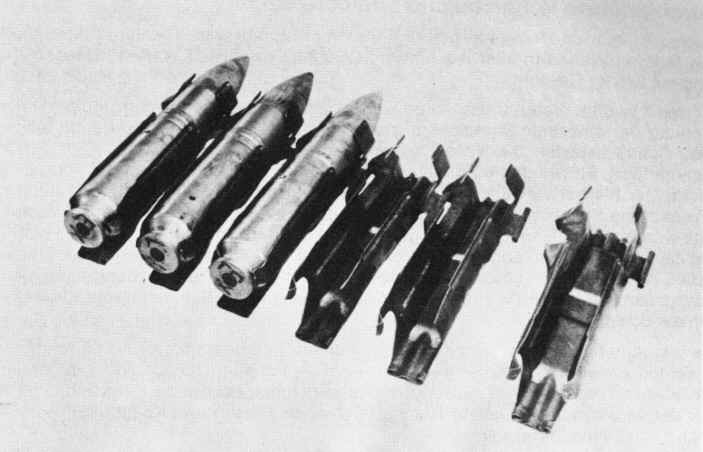Two nice illustrations of how the revolver gun works:http://www.warbirds.jp/truth/s_rgun.htm
In post #74 here it is stated that the underbelly tests of the syncronized MK103 on the FW190 was a failure.
Can you elaborate on that, why did it fail?
I´ve long wondered why they didn´t do just that, but at least, they tried then…
I don’t know, but I suspect erratic propellant burn. A synchronised gun required very precise timing of each shot to work: the instant of the projectile passing through the propeller disc had to be guaranteed to within a tiny fraction of a second to ensure that it didn’t hit a blade. The MK 103 used a very big 30x184B cartridge case containing a lot of propellant; I suspect that the time this took to burn varied too much for reliable synchronisation.
And while a propeller blade could tolerate the odd bullet hole through it, a 30mm shell would destroy it.
In post #74 here it is stated that the underbelly tests of the syncronized MK103 on the FW190 was a failure.
Can you elaborate on that, why did it fail?
I think Tony pretty much explained it, the so called “hang fires” could disrupt the sinchronizer interruption and destroy the propellers. The rate of fire in the MK-103 varied continuosly between 360-420 rpm, that is 6 or 7 shots per second.
Thanks both of you:D
Perhaps you can tell me if there wasn´t some trouble involved with the quite different muzzle velocities of the different ammu types for the same gun. They don´t seem to present a ballistic match?
Or did they use only one ammu type at a time?
More, more, more on the MG213/20, MG213/30 please :twisted:
I think that they would have had to “tune” the synchro system for a particular ammo loading
Here is a more or less known german site. But the manuals are somewhat difficult to find. Interesting manuals about weapons, engines, instument data sheets. F.e. the remote controlled guns of the He 177 ect .
http://www.cockpitinstrumente.de/archiv/Dokumente/web/new%20site/frames2/Dokumente.htm
check it out - for Heinkel click an “H”
55 mm MK 112.
Rheinmetall Borsig design for a heavy fast firing cannon, it was more or less an up-scaled variant of the successful 30 mm MK 108. The requeriment of 1944 included the need of a cheap construction and not to used a lot of high grade steel, in this way contruction involved several parts of stamped and welded metal.

The calibre was 55 x 175 mm, rate of fire-300-350 rpm, the projectiles used were minengranate exclusively.
Just one more image of the MK-112 55 mm weapon. the muzzle velocity was 530-550 m/s.

You will note that the shape of the cartridges shown in the two drawings is very different…the first one is about right, the second one wrong.
The trials with captured aircraft wings and parts show that about 450gramms of explosive is nessessary to seriously destroy a bomber. That resulted in a caliber of 5,5cm. They made 17 light guns, but the test firing showed that the belt links are too fragile. There are a light 300 kg and a heavy version (max. 700kg and V° 1000 m/sek) and different ammunition.
Here is the MK108 type rebated case ammo for the light version. ( 600 m/sek a rate of fire of 350 rds/sek was reached)
Sehr Gut, thanks for the 55x175mm patrone pictures Lothar.

You will note that the shape of the cartridges shown in the two drawings is very different…the first one is about right, the second one wrong.
Yup, that is a cheap squematic drawing, interestingly enough the competition of MK-108, the Mauser Mk 212 did use a bottlenecked case cartrigde.
There are a light 300 kg and a heavy version (max. 700kg and V° 1000 m/sek) and different ammunition.
Probably you are talking about the MK-114 wich used the 55 mm “Gerät 58” AAA cartrigde.
Rheinmetall MK-115 .
I know this was a recoil reduced full automatic high velocity 55 mm calibre gun. Unfortunately no more data, any pictures or squematic would be preciated.
The MK 115 was a recoilless autoloading gun firing combustible-case ammo. It therefore combined two technologies, neither of which has reached production status in an automatic cannon to this day (despite many atttempts). That should give you some idea of its feasibility :roll:
Combustible case ? hmm, interesting that data is one I didnt know, the design sounds even more complicated than I tough but of course in this level that matter does not surprize me.
The only recoiless full auto gun I know is the RMK 30.

The were some Russian self-loading RCLs in the 1930s, but they didn’t have combustible cases and saw little use. The RMK 30 is AFAIK the only auto cannon to have been made which combines RCL with combustible case. However, that is not in service and may never be.
I think I read something about put it in the Eurocopter Tiger…
Here I found a squematic of the MK 115.

They were talking about that at one time, but there are no current plans to do so.
Understood. 
At last I can put this image, I had saw this in WW2aircraft.net but given the troubles with that website I cannot do before.
In this squematic in better apreaciated the intrincated design of the Rheinmetall Borsig MK 115 55mm gun.


